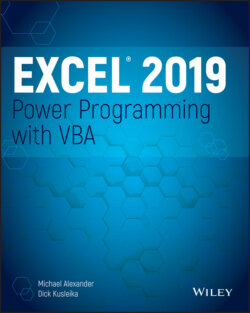Читать книгу Excel 2019 Power Programming with VBA - Michael Alexander, Dick Kusleika - Страница 105
VBA Fundamentals
ОглавлениеVBA is an object-oriented programming language. The basic concept of object-oriented programming is that a software application (Excel in this case) consists of various individual objects. An Excel application contains workbooks, worksheets, cells, charts, pivot tables, shapes, and the list goes on. Each object has its own set of attributes, which are called properties, and its own set of actions, called methods.
You can think of this concept just as you would of the objects you encounter every day, such as your computer or your car. Each of those objects has attributes, such as height, weight, and color. They also have their own distinct actions. For instance, your computer boots up, and your program starts.
VBA objects also have their identifiable attributes and actions. A workbook, for example, is an object with attributes (properties), such as its name, the number of worksheets it contains, and the date it was created. A workbook object also has actions (methods) such as Open, Close, and Save.
In Excel, you deal with objects such as workbooks, worksheets, and ranges on a daily basis. You likely think of each of these “objects” as all part of Excel, not really separating them in your mind. However, Excel thinks about these internally as all part of a hierarchical model called the Excel Object Model. The Excel Object Model is a clearly defined set of objects that are structured according to the relationships among them.
